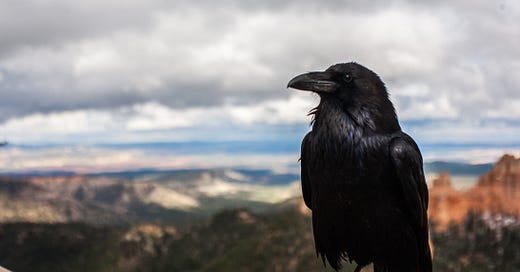“Through the function of the absent referent, Western culture constantly renders the material reality of violence into controlled and controllable metaphors.”
—Carol J. Adams,
The Sexual Politics of Meat
Just Survive
Fear keeps us alive. Our fear of isolation, rejection, and death protected our ancestors long enough to procreate and pass down their fearsome genes. Fear is the reason why we all exist today. Fear is primal.
And yet we seek fear out. We watch scary movies and read horror novels, tour haunted houses, ride rollercoasters, and practice extreme sports. We say “I love you” for the first time, start new jobs, move to new places, and try new foods.
Facing fear—and overcoming danger—is exhilarating.
The Allure of Terror
As I began exploring the horror genre from an animal rights perspective, I was surprised to find that many of the stories could be analogized to animal issues. Sure, there’s The Texas Chain Saw Massacre, where humans are slaughtered and eaten like animals, but there’s also Shirley Jackson’s brilliant short story, “The Lottery,” which provides an omniscient perspective on our senseless dedication to harmful traditions.
Horror often draws comparisons to the terrors animals face because our interactions with nearly all nonhuman species are violent. To them, we are the monster under the bed, the demon in the basement, the zombie at the door.
This unfortunate fact is effective in scary stories because we recognize that how humans regard animals is foundational to our oppression of other humans. Groups are oppressed and abused by lowering their status to that of beasts; by stripping them of humanity, oppressors give themselves permission to treat them as nonhuman (read: subhuman).
Michael Myers, for instance, though technically human (I think?), sees his victims as nothing more than meat. (Literally. Check out the Halloween Kills novelization.) His sole purpose is to kill; he doesn’t care how nice of a guy you are. He is the slaughterer, we are the lambs.
Most horror is based on the accepted presumption that the barbaric acts committed by the monster are wrong because they treat humans “like animals.” As in, brutally killing humans is unequivocally immoral, but brutally killing animals really isn’t a big deal. (Ironically, the human deaths in horror are often shown in vivid detail, while the animal deaths are rarely shown at all.) However, horror also gives us the opportunity to show that what we do to animals is inherently immoral.
Broadening the Metaphor
Carol J. Adams notes in her seminal work, The Sexual Politics of Meat, that the “function of the absent referent is to keep our ‘meat’ separated from any idea that she or he was once an animal.”
The same can be said for fiction. The constructs of a fictional setting separate the story from real-world terrors. This allows us to both process trauma from a safe place but also overlook its realism. We can face some of the most grotesque gore and heartbreaking violence on a page or a screen but hardly a modicum of that terror in reality. (Even in horror, certain lines are rarely crossed, such as violence to animals and children.)
With horror, we can ask the audience to confront the referent by not just metaphorically relating to animals—though that is certainly common—but also by placing them directly in the animals’ position to experience their lives. And for us, the lives of domesticated animals are a whole new circle of hell, whether they experience the physical agony of unanesthetized castration or the mental anguish of ceaseless boredom. No other genre asks its audience to stew in this terror and fully empathize with the characters.
Horror has limitless untapped potential for animal rights advocacy. Modern movies—ranging from low-budget indies like The Farm to mega-blockbusters like Nope—have toyed with the concept, but there is significant room for progress.
An Example
One film that effectively utilizes metaphor to bring animals out of their role as the absent referent (without hitting you over the head) is The Block Island Sound. The story revolves around the return of a man, Tom, to his family after being abducted by aliens on his boat.
Later, Tom’s daughter—Audry, a researcher for the EPA—visits to investigate the mass deaths of fishes (which we discover are caused by their abduction). She tells her daughter that she doesn’t harm the fishes she studies, instead returning them to their homes to live the rest of their lives happily.
Tom’s behavior following his abduction becomes increasingly bizarre and disturbing, proving that whatever happened permanently altered him. Tom is then abducted again and later found dead.
At the end of the movie, Audry is abducted and then released, just as her father was, and the same speech she gave her daughter earlier in the film plays as she treads water, forever traumatized by the experience.
The filmmakers didn’t merely place humans in the role of animals, as most horror movies do. They tied the story together at the end by spotlighting Audry’s speciesism, projecting what she wants to believe about the fishes she abducts onto her own abduction. The audience is forced to reexamine the events of the movie, to explore the abusive relationship between humans and aliens (the external plot) and humans and fishes (the internal story). Far too few stories make this full connection, and it was like a gulp of fresh water.
Awaken Your Monster
No other genre delves into the animalistic side of humanity as regularly as horror, and how humanity treats animals is a sort of depravity too wicked to be overlooked. As horror so often does, it’s time to push the limits of accepted normality and supposed morality of modern society by shining a light on the hidden horrors of animal oppression.
In subsequent posts, I will delve into how I’d like to see horror, and fiction in general, address animal issues (without sounding like preachy, holier-than-thou radicals).
be conscious, be kind, be vegan




